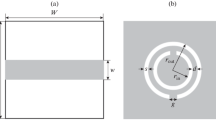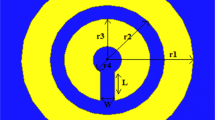Abstract
In this paper planar and compact band stop filter using split ring resonator (SRR) metamaterial is proposed. Band stop type attenuation is presented from L-to X-band. Low insertion loss in the pass band and high attenuation in the stop band can be considered as the advantage of this filter. Filter characteristics of SRR is presented using microstrip line. Here SRR is introduced in the substrate layer of microstrip line. It has been observed that the rejection level of the filter in stop band goes on increasing as we increase the number of SRR in the structure. Size of SRR is much less than the operating wavelength thereby several SRR can be introduced in substrate layer to provide a compact structure with high rejection level in the stop band. The frequency of filtering depends on the dimensions of SRR. The effect of varying the dimensions of SRR on the filtering frequency is also presented in this paper. It has also been observed by Nicolson-Ross-Weir approach that at the filtering frequency, value of relative permeability as well as relative permittivity for this structure is negative. This confirms that this structure behaves as a Left Handed medium.















Similar content being viewed by others
References
Rajo-Iglesias, E., Quevedo-Teruel, O., & Inclan-Sanchez, L. (2008). Mutual coupling reduction in patch antenna arrays by using a planar EBG structure and a multilayer dielectric substrate. IEEE Transactions on Antennas and Propagation, 56, 1648–1655.
Rahmat-Samii, Y., & Mosallaei, H. (2001). Electromagnetic band- gap structures: Classification, characterization and applications. In Proceedings of IEEE ICAP Symposium, pp. 560–564.
Yang, L., Fan, M., Chen, F., She, J., & Feng, Z. (2005). A novel compact electromagnetic bandgap EBG structute and its applications for micro-wave circuits. IEEE Transactions on Microwave Theory and Techniques, 53, 183–190.
Yang, F., & Rahmat-samii, Y. (2003). Microstrip antenna integrated with electromagnetic band gap (EBG) structures: A low mutual coupling design for array applications. IEEE Transactions on Antennas and Propagation, 51(10, pt. 2), 2936–2946.
Fu, Y., & Yuan, N. (2004). Elimination of scan blindness in phased array of microstrip patches using electromagnetic band gap materials. IEEE Antennas and Wireless Propagation Letters, 3, 64–65.
Dadashzadeh, G., Dadgarpour, A., Jolani, F., & Virdee, B. S. (2011). Mutual coupling suppression in closely spaced antennas. IET Microwaves Antennas & Propagation, 5, 113–125.
Buell, K., Mosallaei, H., & Sarabandi, K. (2007). Metamaterial insulator enabled superdirective array. IEEE Transactions on Antennas and Propagation, 55(4), 1085.
Rahmat-Samii, Y., & Yang, F. (2009). Electromagnetic band gap structures in antenna engineering. Cambridge: Cambridge University Press.
Hammerstad, E., & Jensen, Ø. (1980). Accurate models for microstrip computer-aided design. In Symposium on Microwave Theory and Techniques, pp. 407–409, June 1980.
Hammerstard, E.O. (1975). Equations for microstrip circuit design. In: Proceedings of the European microwave conference, Hamburg, Germany, pp. 268–272.
Wheeler, H. (1965). Transmission line properties of parallel strips separated by a dielectric sheet. IEEE Transactions, MTT–13, 172–185.
Vesalago, V. G. (1968). The electrodynamics of substances with simultaneously negative values of permittivity and magnetic permeability. Soviet Physics USPEKHI, 10, 509–514.
Pendry, J. B., Holden, A. J., Stewart, W. J., & Youngs, I. (1996). Extremely low frequency plasmas in metallic microstructures. Physical Review Letters, 76, 4773–4776.
Pendry, J. B., Holden, A. J., Robbins, D. J., & Stewart, W. J. (1999). Magnetism from conductors and enhanced nonlinear phenomena. IEEE Transactions on Microwave Theory and Techniques, 47(11), 2075–2084.
Marques, R., Medina, F., & Rafi-EI-Idrissi, R. (2002). Role of bianisotropy in negative permeability and left handed Metamaterials. Physical Review B Condensed Matter, 65, 144441(1)–144441(6).
Marques, R., Mesa, F., Martel, J., & Medina, F. (2003). Comparative Analysis of edge-and broadside-coupled split ring resonatorfor metamaterial design—Theory and experiment. IEEE Transactions on Antennas and Propagation, 51(10), 2572–2581.
Author information
Authors and Affiliations
Corresponding author
Rights and permissions
About this article
Cite this article
Gupta, M., Saxena, J. Microstrip Filter Designing by SRR Metamaterial. Wireless Pers Commun 71, 3011–3022 (2013). https://doi.org/10.1007/s11277-012-0986-7
Published:
Issue Date:
DOI: https://doi.org/10.1007/s11277-012-0986-7




